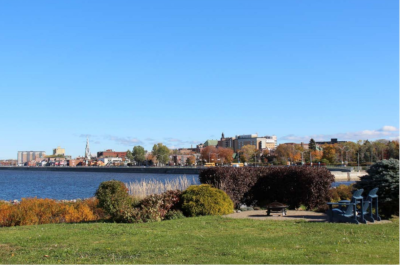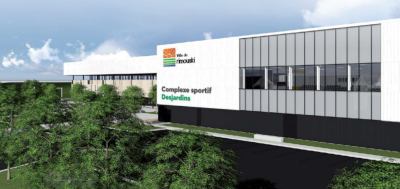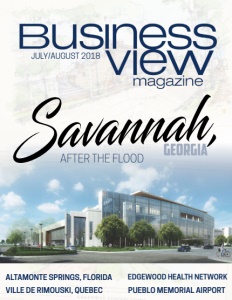Ville de Rimouski, Quebec
Strength in the blue economy
Business View Magazine interviews Marc Parent, Mayor of the Ville de Rimouski, Quebec, for our focus on innovation and community development in Canadian cities.
A major urban center in the Bas-Saint-Laurent administrative region, the City of Rimouski is ideally located on the shores of the St. Lawrence River, where residents enjoy an exceptional quality of life and entrepreneurs are welcomed and prized. This thriving regional metropolis is a hub for businesses, personal and professional services, educational institutions, health care facilities, and home base to a variety of corporate headquarters and administrative centers that drive the city’s economic engine.
 Surrounded by a natural laboratory, and home to many research and teaching centres, Rimouski has earned status as the Marine Technopole of Quebec. The city’s commercial seaport strategically opens to large European markets and the Canadian and American Great Lakes. Specialists in maritime technologies and applied research (Innovation Maritime) and intermodal maritime transport (CFoRT) make the port of Rimouski an important center for development of maritime transport and technology.
Surrounded by a natural laboratory, and home to many research and teaching centres, Rimouski has earned status as the Marine Technopole of Quebec. The city’s commercial seaport strategically opens to large European markets and the Canadian and American Great Lakes. Specialists in maritime technologies and applied research (Innovation Maritime) and intermodal maritime transport (CFoRT) make the port of Rimouski an important center for development of maritime transport and technology.
Mayor of Rimouski, Marc Parent, shares, “People relocate here from Montreal and Quebec City, when they realize if they want to move forward professionally and maintain a great quality of life, that Rimouski, with its 50,000 people, offers all of that.” The Complexe Sportif Desjardins project, seen as one of the missing stones in the infrastructure of Rimouski, is a great example. The city was short of recreational facilities – swimming pools, ice rinks – so it made a proposal, supported by the provincial and federal governments, and in April 2017, the $40 million project was announced.
“We were extremely well-prepared,” says Parent, “from the get-go, that project was developed with the involvement of all the potential users. Among the most active was the University of Quebec at Rimouski (UQAR). Three months after the announcement, we started digging and the Complex will be finished in Dec. 2018. We’re actually ahead of schedule on construction and right on budget. The site used to be UQAR property, but the University sold us the land for the Complex for one dollar – it’s a great partnership.”
The building is following all the guidelines to meet Gold LEED criteria. Advanced technology includes recouping all the excess heat generated by the cooling system for the two ice surfaces (Olympic and North American sizes) and using it to heat the 6800 square foot semi-Olympic pool as well as the 5,000 square foot recreational pool. That pool features a huge family-focused component to make it inclusive for the whole community, not just the elite. As Parent says, “This is a facility designed for ages 0 to 105 – we have a tendency to live old here.”
Jean Pierre Ouellet is the rector at UQAR, and heavily involved in the University’s collaboration with the sports complex. He notes, “We will have access to a laboratory within the complex and we’ll use that to develop a kinesiology health program around physical activity; assessing physical fitness through research at this facility. It’s tightly linked to the University, so it will become an asset for us to attract new students.” In addition to municipal, provincial, and federal financing, the complex was also funded by Desjardins. The company’s $4 million contribution to the project earned them naming rights and tremendous thanks from the community.
Telus Canada is the region’s fiber optic provider. By the end of the summer, 99 percent of the population will be connected to fiber optic, allowing access to 1GB per second upload/download speed. The Rimouski area is far exceeding internet capacity currently available in Montreal, Vancouver, or Calgary. Not only will residents benefit, all of the industrial parks, the University, and health sector now have access, as well. Parent explains, “Telus Quebec has a huge base of operations here, with 1400 workers. They rolled out Telus TV in Rimouski and they’re doing the same for fiber optic. It’s a great asset for us to have this huge corporate partner based in our city. According to Telus, we’re the most connected region in Canada right now. That’s their official line.”
Health services and related businesses are major employers. There are 8,000 workers in health services in the lower St. Lawrence region; many of those in Rimouski at the area’s original healthcare center. Telus is the next largest employer with 1,400, and a couple other companies have 700 to 1,000. Rimouski also has a vibrant SME economy with several industries in the range of 50 to 200 employees. The University has 500 full-time employees, and 600 global researchers in Marine Science work at the three maritime research centres: the Institut des sciences de la mer, (marine sciences institute); the Institut maritime du Québec, (Quebec maritime institute); and the Maurice Lamontagne Institute (Canadian government marine sciences research center). Hydro-Québec’s regional service centre, the courthouse, and federal and provincial agencies add to employment numbers in the services sector.
Agribusiness, biomass exploitation, applied forestry technologies, sustainable development, environmental industries, and new information and communication technologies (NICT) complete the economic diversity. Twenty-nine percent of Rimouski residents between 25 and 64 hold university degrees; seventy-two percent hold post-secondary qualifications. Parent says, “Thanks to the University, we have a large number of highly-trained human resources, so our population is growing – rather unusual for the rural part of Quebec, which is a great thing. And the jobs we are creating are good quality requiring a high skill level. Right now, we’re recruiting a lot of specialists in IT platforms.”
Ouellet adds, “The city itself is highly educated because of the University and the research centers. We have two main campuses, one in Lévis and the main one in Rimouski, and offer services over a large area. UQAR welcomes close to 7,000 students every year from 40 countries. We’ve been ranked in the top three in Canada in our category for the last six years, in terms of research performance. All aspects of marine sciences are explored using our top-notch research facilities, a 50-metre-long research vessel, and a micro-culture laboratory supplied year-round with sea water. We are well equipped, and our highly-skilled researchers are known throughout the world.”
 The St. Lawrence River ‘Odyssey’ research program was just launched with a $15 million government investment. The mandate is to glean a better understanding of the river – the impact of climate change and the increase of maritime transportation – and look for ways to reduce negative impacts. Parent acknowledges, “From a Mayoral point of view, the impact of global warming with higher tides, storms, and the ice coverage not as prominent as it used to be, has some residents worried. The University research provides us with a better understanding of this new reality and a mechanism we could put in place to either modify the rules around the establishment of properties or give guidelines before allowing folks to build a new residence.
The St. Lawrence River ‘Odyssey’ research program was just launched with a $15 million government investment. The mandate is to glean a better understanding of the river – the impact of climate change and the increase of maritime transportation – and look for ways to reduce negative impacts. Parent acknowledges, “From a Mayoral point of view, the impact of global warming with higher tides, storms, and the ice coverage not as prominent as it used to be, has some residents worried. The University research provides us with a better understanding of this new reality and a mechanism we could put in place to either modify the rules around the establishment of properties or give guidelines before allowing folks to build a new residence.
“One of the strengths of Rimouski in the blue economy – we’re not building ships, but we’re building the knowledge around all those traditional activities. We have companies optimizing consumption of fuel for boats and we just signed a huge contract with the Coast Guard for that.” Smart buoys collect big data and interact with scientists to look at the impact of sailing on the environment and improving ship design. Rimouski has a new industry developing technology for diving that connects surveying and infrastructure data companies and the research centers.
Parent is especially proud of all the small business spin-offs started by young people just out of university. “They look at innovating and we provide the tools; they do it locally, but they sell it globally,” he reports. “We work together to promote the entrepreneurial culture and help them succeed. Quality of life here is exceptional. Folks can go salmon fishing along the Rimouski River in the morning just before going to work a short distance away. Almost everything is possible here in terms of activities, museums, music, art, history. Rimouski is a great place for families to live, work, and grow.”
A major urban center in the Bas-Saint-Laurent administrative region, the City of Rimouski is ideally located on the shores of the St. Lawrence River, where residents enjoy an exceptional quality of life and entrepreneurs are welcomed and prized. This thriving regional metropolis is a hub for businesses, personal and professional services, educational institutions, health care facilities, and home base to a variety of corporate headquarters and administrative centers that drive the city’s economic engine.
Surrounded by a natural laboratory, and home to many research and teaching centres, Rimouski has earned status as the Marine Technopole of Quebec. The city’s commercial seaport strategically opens to large European markets and the Canadian and American Great Lakes. Specialists in maritime technologies and applied research (Innovation Maritime) and intermodal maritime transport (CFoRT) make the port of Rimouski an important center for development of maritime transport and technology.
Mayor of Rimouski, Marc Parent, shares, “People relocate here from Montreal and Quebec City, when they realize if they want to move forward professionally and maintain a great quality of life, that Rimouski, with its 50,000 people, offers all of that.” The Complexe Sportif Desjardins project, seen as one of the missing stones in the infrastructure of Rimouski, is a great example. The city was short of recreational facilities – swimming pools, ice rinks – so it made a proposal, supported by the provincial and federal governments, and in April 2017, the $40 million project was announced.
“We were extremely well-prepared,” says Parent, “from the get-go, that project was developed with the involvement of all the potential users. Among the most active was the University of Quebec at Rimouski (UQAR). Three months after the announcement, we started digging and the Complex will be finished in Dec. 2018. We’re actually ahead of schedule on construction and right on budget. The site used to be UQAR property, but the University sold us the land for the Complex for one dollar – it’s a great partnership.”
The building is following all the guidelines to meet Gold LEED criteria. Advanced technology includes recouping all the excess heat generated by the cooling system for the two ice surfaces (Olympic and North American sizes) and using it to heat the 6800 square foot semi-Olympic pool as well as the 5,000 square foot recreational pool. That pool features a huge family-focused component to make it inclusive for the whole community, not just the elite. As Parent says, “This is a facility designed for ages 0 to 105 – we have a tendency to live old here.”
Jean Pierre Ouellet is the rector at UQAR, and heavily involved in the University’s collaboration with the sports complex. He notes, “We will have access to a laboratory within the complex and we’ll use that to develop a kinesiology health program around physical activity; assessing physical fitness through research at this facility. It’s tightly linked to the University, so it will become an asset for us to attract new students.” In addition to municipal, provincial, and federal financing, the complex was also funded by Desjardins. The company’s $4 million contribution to the project earned them naming rights and tremendous thanks from the community.
Telus Canada is the region’s fiber optic provider. By the end of the summer, 99 percent of the population will be connected to fiber optic, allowing access to 1GB per second upload/download speed. The Rimouski area is far exceeding internet capacity currently available in Montreal, Vancouver, or Calgary. Not only will residents benefit, all of the industrial parks, the University, and health sector now have access, as well. Parent explains, “Telus Quebec has a huge base of operations here, with 1400 workers. They rolled out Telus TV in Rimouski and they’re doing the same for fiber optic. It’s a great asset for us to have this huge corporate partner based in our city. According to Telus, we’re the most connected region in Canada right now. That’s their official line.”
Health services and related businesses are major employers. There are 8,000 workers in health services in the lower St. Lawrence region; many of those in Rimouski at the area’s original healthcare center. Telus is the next largest employer with 1,400, and a couple other companies have 700 to 1,000. Rimouski also has a vibrant SME economy with several industries in the range of 50 to 200 employees. The University has 500 full-time employees, and 600 global researchers in Marine Science work at the three maritime research centres: the Institut des sciences de la mer, (marine sciences institute); the Institut maritime du Québec, (Quebec maritime institute); and the Maurice Lamontagne Institute (Canadian government marine sciences research center). Hydro-Québec’s regional service centre, the courthouse, and federal and provincial agencies add to employment numbers in the services sector.
Agribusiness, biomass exploitation, applied forestry technologies, sustainable development, environmental industries, and new information and communication technologies (NICT) complete the economic diversity. Twenty-nine percent of Rimouski residents between 25 and 64 hold university degrees; seventy-two percent hold post-secondary qualifications. Parent says, “Thanks to the University, we have a large number of highly-trained human resources, so our population is growing – rather unusual for the rural part of Quebec, which is a great thing. And the jobs we are creating are good quality requiring a high skill level. Right now, we’re recruiting a lot of specialists in IT platforms.”

Ouellet adds, “The city itself is highly educated because of the University and the research centers. We have two main campuses, one in Lévis and the main one in Rimouski, and offer services over a large area. UQAR welcomes close to 7,000 students every year from 40 countries. We’ve been ranked in the top three in Canada in our category for the last six years, in terms of research performance. All aspects of marine sciences are explored using our top-notch research facilities, a 50-metre-long research vessel, and a micro-culture laboratory supplied year-round with sea water. We are well equipped, and our highly-skilled researchers are known throughout the world.”
The St. Lawrence River ‘Odyssey’ research program was just launched with a $15 million government investment. The mandate is to glean a better understanding of the river – the impact of climate change and the increase of maritime transportation – and look for ways to reduce negative impacts. Parent acknowledges, “From a Mayoral point of view, the impact of global warming with higher tides, storms, and the ice coverage not as prominent as it used to be, has some residents worried. The University research provides us with a better understanding of this new reality and a mechanism we could put in place to either modify the rules around the establishment of properties or give guidelines before allowing folks to build a new residence.
“One of the strengths of Rimouski in the blue economy – we’re not building ships, but we’re building the knowledge around all those traditional activities. We have companies optimizing consumption of fuel for boats and we just signed a huge contract with the Coast Guard for that.” Smart buoys collect big data and interact with scientists to look at the impact of sailing on the environment and improving ship design. Rimouski has a new industry developing technology for diving that connects surveying and infrastructure data companies and the research centers.
Parent is especially proud of all the small business spin-offs started by young people just out of university. “They look at innovating and we provide the tools; they do it locally, but they sell it globally,” he reports. “We work together to promote the entrepreneurial culture and help them succeed. Quality of life here is exceptional. Folks can go salmon fishing along the Rimouski River in the morning just before going to work a short distance away. Almost everything is possible here in terms of activities, museums, music, art, history. Rimouski is a great place for families to live, work, and grow.”
Check out this handpicked feature on Saskatoon Saskatchewan – Growth and opportunity.
AT A GLANCE
WHO: Ville de Rimouski, Quebec
WHAT: Maritime City on the St. Lawrence River, population 50,000
WHERE: Lower St. Lawrence Region, Quebec
WEBSITE: www.ville.rimouski.qc.ca


2 comments
[…] Check out this handpicked feature on Ville de Rimouski, Quebec – Strength in the blue economy. […]
[…] Check out this handpicked feature on Ville de Rimouski, Quebec – Strength in the blue economy. […]
Comments are closed.